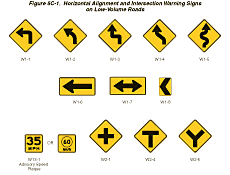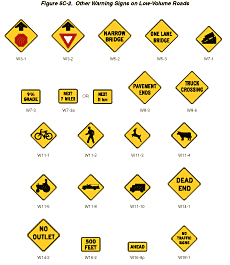Chapter 5C. Warning Signs
Section 5C.01 Introduction
Support:
The purpose of a warning sign is to provide advance warning to the
road user of unexpected conditions on or adjacent to the roadway
that might not be readily apparent.
The criteria for warning signs are contained in Chapter 2C and in other Sections of this Manual. Criteria for warning signs that are specific to low-volume roads are contained in this Chapter.
Section 5C.02 Horizontal Alignment Signs (W1-1 through W1-8)
Support:
Horizontal Alignment signs (see Figure 5C-1) include turn, curve,
reverse turn, reverse curve, winding road, large arrow, and chevron
alignment signs.
Figure 5C-1 Horizontal Alignment and Intersection Warning Signs on Low-Volume Roads

Option:
Horizontal Alignment signs may be used where engineering judgment
indicates a need to inform the road user of a change in the horizontal
alignment of the roadway.
Section 5C.03 Intersection Warning Signs (W2-1 through W2-5)
Support:
Intersection signs (see Figure 5C-1) include the crossroad, side
road, T-symbol, and Y-symbol signs.
Option:
Intersection signs may be used where engineering judgment indicates
a need to inform the road user in advance of an intersection.
Section 5C.04 Stop Ahead and Yield Ahead Signs (W3-1, W3-2)
Standard:
A Stop Ahead (W3-1) sign (see Figure 5C-2) shall be used where a
STOP sign is not visible for a sufficient distance to permit the
road user to bring the vehicle to a stop at the STOP sign.
A Yield Ahead (W3-2) sign (see Figure 5C-2) shall be used where a YIELD sign is not visible for a sufficient distance to permit the road user to bring the vehicle to a stop, if necessary, at the YIELD sign.
Figure 5C-2 Other Warning Signs on Low-Volume Roads

Option: Word message (W3-1a and W3-2a) signs may be used as alternates to symbol signs.
Section 5C.05 NARROW BRIDGE Sign (W5-2)
Option:
The NARROW BRIDGE (W5-2) sign (see Figure 5C-2) may be used on an
approach to a bridge or culvert that has a clear width less than
that of the approach roadway.
Section 5C.06 ONE LANE BRIDGE Sign (W5-3)
Guidance:
A ONE LANE BRIDGE (W5-3) sign (see Figure 5C-2) should be used on
low-volume two-way roadways in advance of any bridge or culvert:
- Having a clear roadway width of less than 4.9 m (16 ft); or
- Having a clear roadway width of less than 5.5 m (18 ft) when commercial vehicles constitute a high proportion of the traffic; or
- Having a clear roadway width of 5.5 m (18 ft) or less where the approach sight distance is limited on the approach to the structure.
Option:
Roadway alignment and additional warning may be provided on the
approach to a bridge or culvert by the use of object markers and/or
delineators.
Section 5C.07 Hill Sign (W7-1)
Option:
An engineering study of vehicles and road characteristics, such
as percent grade and length of grade, may be conducted to determine
hill signing requirements.
The use of the Hill (W7-1) sign (see Figure 5C-2) on low-volume roads may be confined to roads where commercial or recreational vehicles are anticipated.
Word messages (W7-1a) may be used as alternates to symbols.
Section 5C.08 PAVEMENT ENDS Sign (W8-3)
Option:
A PAVEMENT ENDS (W8-3) sign (see Figure 5C-2) may be used to warn
road users where a paved surface changes to a gravel or earth road
surface.
Section 5C.09 Vehicular Traffic and Nonvehicular Signs (W11 Series and W8-6)
Guidance:
Vehicular Traffic signs (see Figure 5C-2) should be used to alert
road users to frequent unexpected entries into the roadway by trucks,
bicyclists, farm vehicles, fire trucks, and other vehicles. Such
signs should be used only at locations where the road user’s
sight distance is restricted or the activity would be unexpected.
Option:
Nonvehicular signs (see Figure 5C-2) may be used to alert the road
user to frequent unexpected entries into the roadway by pedestrian,
animal, and other crossing activities that may cause potential conflicts.
A W7-3a, W16-2, or W16-9p supplemental plaque (see Figure 5C-2), with the legend NEXT XX km (NEXT XX MILES), XX METERS (XX FEET), or AHEAD may be installed below a Vehicular Traffic or Nonvehicular sign (see Sections 2C.40 and 2C.41).
Guidance:
If the activity is seasonal or temporary, the sign should be removed
or covered when the crossing activity does not exist.
Section 5C.10 Advisory Speed Plaque (W13-1)
Option:
An Advisory Speed (W13-1) plaque (see Figure
5C-1) may be mounted below a warning sign when the condition
requires a reduced speed.
Section 5C.11 DEAD END or NO OUTLET Signs (W14-1, W14-1a, W14-2, W14-2a)
Option:
The DEAD END (W14-1) and NO OUTLET (W14-2) signs (see Figure 5C-2)
and the DEAD END (W14-1a) and NO OUTLET (W14-2a) signs (see Figure
2C-3) plaques may be used to warn road users of a road that has
no outlet or that terminates in a dead end or cul-de-sac.
Guidance:
If used, these signs should be placed at a location that gives drivers
of large commercial or recreational vehicles an opportunity to select
a different route or turn around.
Section 5C.12 NO TRAFFIC SIGNS Sign (W18-1)
Option:
A W18-1 warning sign (see Figure 5C-2)
with the legend NO TRAFFIC SIGNS may be used only on unpaved, low-volume
roads to advise users that no signs are installed along the distance
of the road. If used, the sign may be installed at the point where
road users would enter the low-volume road or where, based on engineering
judgment, the road user may need this information.
A W7-3a, W16-2, or W16-9p supplemental plaque (see Figure 5C-2) with the legend NEXT XX km (NEXT XX MILES), XX METERS (XX FEET), or AHEAD may be installed below the W18-1 sign when appropriate.
Section 5C.13 Other Warning Signs
Standard:
Other warning signs used on low-volume roads that are not discussed
in Part 5, but are in this Manual, shall
conform with the criteria contained in other Parts of this Manual.
Warning signs that are not specified in this Manual shall conform
to the criteria in Sections 2C.02
and 2C.03.
